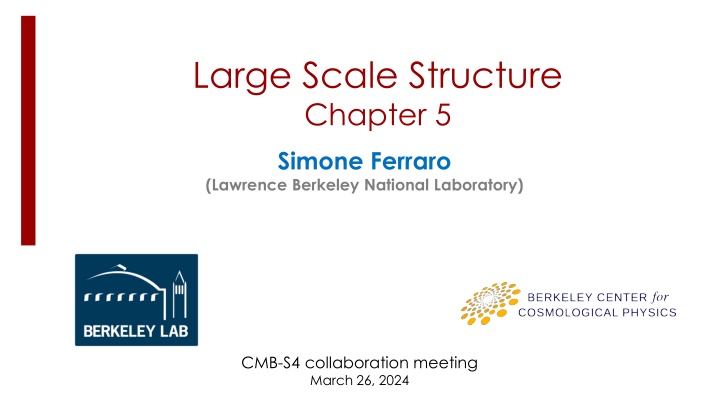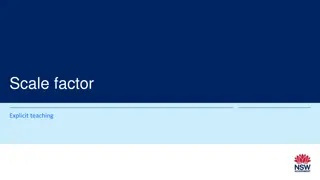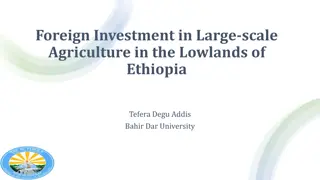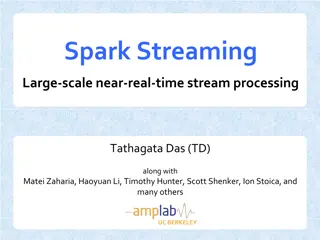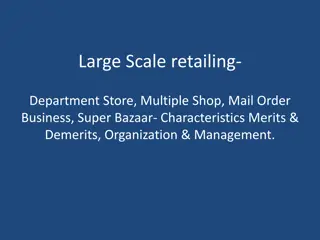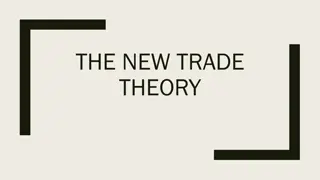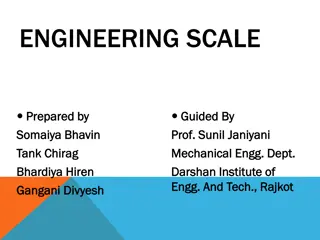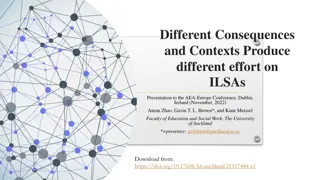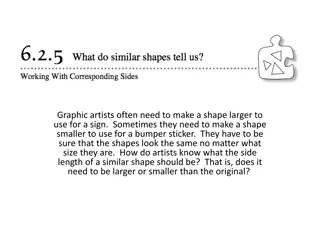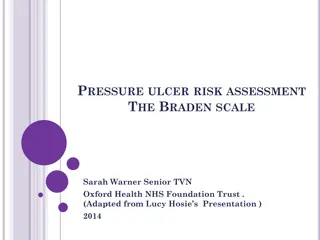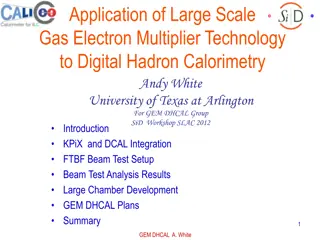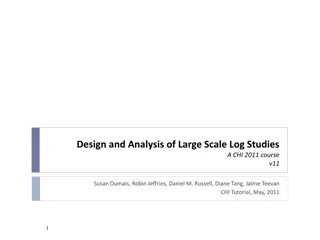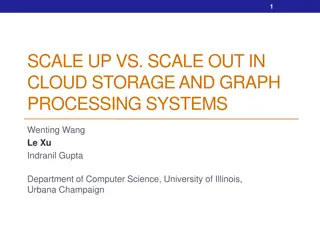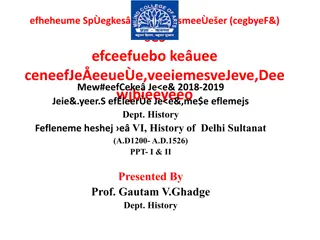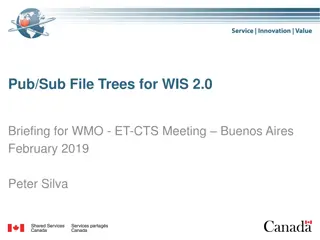Large Scale Structure Chapter 5
Simone Ferraro from Lawrence Berkeley National Laboratory discusses the significance of Cosmic Microwave Background (CMB) experiments in probing the large-scale structure of the universe. Covering topics like the interaction of photons with matter, CMB lensing, and CMB lensing tomography, this presentation sheds light on the research goals in understanding the growth of structure across redshifts and testing General Relativity. The ambitious CMB-S4 collaboration aims for deep-wides surveys to unveil unprecedented insights into cosmic evolution.
Download Presentation

Please find below an Image/Link to download the presentation.
The content on the website is provided AS IS for your information and personal use only. It may not be sold, licensed, or shared on other websites without obtaining consent from the author.If you encounter any issues during the download, it is possible that the publisher has removed the file from their server.
You are allowed to download the files provided on this website for personal or commercial use, subject to the condition that they are used lawfully. All files are the property of their respective owners.
The content on the website is provided AS IS for your information and personal use only. It may not be sold, licensed, or shared on other websites without obtaining consent from the author.
E N D
Presentation Transcript
Large Scale Structure Chapter 5 Simone Ferraro (Lawrence Berkeley National Laboratory) CMB-S4 collaboration meeting March 26, 2024
A brief history of CMB photons 2 94% of photons don t re-scatter (but are lensed!) 6% scatter with matter High-resolution CMB experiments are excellent probes of the Large- Scale Structure! credit: WMAP Simone Ferraro (LBNL)
CMB-S4 Deep-Wide Survey 3 The Deep-Wide Survey will cover ~70% of the sky to unprecedented depth, ensuring overlap with the majority of current and planned surveys VRO/ + ultra-deep survey from the South Pole LAT CMB-S4 collaboration Simone Ferraro (LBNL)
Photons interact with matter 4 Gravitational: lensing, gravitational redshift, Integrated Sachs- Wolfe effect, moving cluster , time delay, Scattering (Thomson/Compton scattering): Thermal Sunyaev-Zeldovich (tSZ), Kinematic Sunyaev-Zeldovich (kSZ), Patchy blurring , screening and scattering, ... (Emission from late time matter): starlight, IR emission from dust, free-free, synchrotron, AME, Simone Ferraro (Berkeley)
CMB lensing with CMB-S4 5 Lensing reconstruction over ~50% of the sky. Total S/N ~ 400. Similar from SPLAT: deeper but from a smaller area. mostly from low z larger contribution from high-z ultimate mass map to z ~ 1100 on large and intermediate scales! Figure credit: Manu Schaan CMB-S4 lensing has comparable statistical power to VRO/LSST shear! very different systematics access to higher redshifts (& source very well understood)
CMB lensing tomography 6 3 main goals: Growth of structure as a function of redshift Testing General Relativity Galaxy-halo connection Cross-correlations are useful because: Convert noise bias into noise More robust to systematics (and can provide cross-calibration: shear bias, photo-z etc). Can isolate part of the signal (eg. from a particular redshift) Can enhance the S/N Not only another measurement of the same parameters: parameter sensitivity evolves with redshift breaking internal degeneracies Also: robust measurements of local fNL Mishra-Sharma et al (2018) Simone Ferraro (LBNL)
Eg: measuring the growth of structure 7 Examples: model independent growth measurement CMB lensing x VRO LSST: S/N ~ 400 In LCDM, improve neutrino mass measurements, while decreasing sensitivity to the optical depth suppression due to massive neutrinos Distinguish the effect of neutrinos from dynamical dark energy + other opportunities: Lyman Alpha forest, HI, other lines, Yu++ (2018) Simone Ferraro (LBNL)
The Sunyaev-Zeldovich effect(s) in temperature 8 kinematic SZ column density of electrons radial velocity thermal SZ patchy screening Baryons are ~16% of the mass major systematic for weak lensing + richphysics for galaxy formation & halo thermodynamics. Also equivalent effects in from screening and scattering in polarization Simone Ferraro (LBNL)
A modern view of galaxy groups cosmological abundance 9 kSZ or patchy screening (density) tSZ (pressure) temperature Schaan, Ferraro., Amodeo, Battaglia + ACT (2021) Amodeo, Battaglia, Schaan, Ferraro + ACT (2021) Coulton et al (ACT) 2024 Also (not shown here): Vavagiakis et al (2021), Soergel et al (SPT) 2016 Calafut et al + (2021), Kusiak et al (2021) + previous literature!
10 Coordinated by Alex Van Engelen and Simone Ferraro Discussed in the Maps to Other Statistics (Maps2Stats) calls. Contribution from many you! For this meeting: What are we missing? We are looking for volunteers to help write the chapter! Simone Ferraro (LBNL)
LSS Chapter Outline pt 1 11 Introduction Science from CMB Lensing CMB Lensing power spectrum CMB Lensing tomography Galaxy lensing - CMB lensing cross-correlations Sunyaev-Zel dovich effects Introduction to the various effects in T & P Probing the gas in and around galaxies Polarized SZ from galaxies (remote quadrupole) Velocity reconstruction (remote dipole). AKA kSZ tomography Rotational kSZ Simone Ferraro (LBNL)
LSS Chapter Outline pt 2 12 Other Cross-correlations CMB x Intensity Mapping (both CIB and Line IM) CIB science & measurement Higher point functions ISW & Rees-Sciama effects Moving lens Reionization Introduction to reionization (both H and He) kSZ 2pt function kSZ 4pt function Reconstructing optical depth fluctuations from patchy screening and scattering Simone Ferraro (LBNL)
13 Thanks! VRO/ Simone Ferraro (LBNL)
14 BACKUP SLIDES Simone Ferraro (LBNL)
kSZ and tSZ cosmology 15 Measuring velocities: Tests of gravity / scale dependence of growth Access to very large-scale modes: no shot noise Sample variance cancellation and ~50% improvement on fNL Achieve (fNL) < 1, beyond primary CMB cosmic variance Large-scale overdensity Cosmology with the tSZ power spectrum/PDF/higher point functions: simultaneously constrain (g)astrophysics and cosmology Simone Ferraro (LBNL)
Halo thermodynamics Emmanuel Schaan & Eve Vavagiakis talks 16 Direct measurement of density, pressure and LOS velocity of the gas in galaxies/clusters Battaglia, S.F., Schaan, Spergel, 2017 Also: Amodeo et al (2021), Moser et al (2021) Very rich physics! One order of magnitude improvement with CMB-S4, especially within the virial radius, Simone Ferraro (LBNL)
Thermodynamic information 17 ~30% non-thermal pressure support Energy injected ~ 30% of binding energy Very rich physics! One order of magnitude improvement with CMB-S4, especially within the virial radius, Battaglia, S.F., Schaan, Spergel, 2017 Simone Ferraro (LBNL)
Baryon effects in weak lensing 18 Calibration of baryon effects in weak lensing: Baryons are ~16% of the mass: statistically large effect on weak lensing CMB lensing cross-correlations & galaxy lensing amplitude often lower than expected. Larger discrepancy on small scales, the most affected by baryons. Surface density of BOSS CMASS galaxies Can this be explained (at least in part) by baryon effects? our range Simone Ferraro (LBNL)
Baryon effects: first direct SZ calibration 19 Direct SZ calibration: Use SZ measurements of gas on the same sample to directly calibrate our prediction First example on BOSS CMASS with ACT data. Explain ~half of the discrepancy + work in progress with A. Leauthaud, J. DeRose, A. Amon and many others! Amodeo, Battaglia, Schaan, Ferraro, Moser + ACT (2021) Simone Ferraro (LBNL)
Projected kSZ2 20 For photometric redshifts (eg. DES, Rubin Observatory, ), usual techniques are suboptimal. Solution: projected fields kSZ! Estimator kSZ2 x (galaxies, shear, 21cm etc ) . Sensitive to halo parameters, just like traditional methods. Potentially very large S/N, but more sensitive to foregrounds Experiment Planck x unWISE (current) SNR 5 Simons Obs. x unWISE (~2023) CMB-S4 x Rubin Obs. ~ 300 > 600 Kusiak et al (2021). Ferraro et al (2016), Hill et al (2016) Simone Ferraro (LBNL)
Other applications 21 Measuring velocities: Tests of gravity / scale dependence of growth Sample variance cancellation and ~50% improvement on fNL Access to very large-scale modes: no shot noise Smith et al (2018) M nchmeyer et al (2018) Patchy Reionization: kSZ: large imprint on high-ell T power, and largest non-Gaussianity. Use 4-pt (Smith & Ferraro) to separate reionization from late-time component. 2-pt + 4-pt very effective at breaking degeneracies! Alvarez, Ferraro, Hill, Hlozek, Ikape (2021) Recent limits from Raghunathan et al (SPT, 2024)
